

"Long red trails lead to the ship showing where loads of pelts have been winched aboard...And there's this mother seal ten feet from me.
She's rocking back and forth, all 300 pounds of her, rhythmically, lifting her mouth to the sky and keening. By her belly is a plum-coloured heap of meat, all that remains of her infant. As I watch her the crying ceases. She makes no futher sound, though she seems to be trying. She rocks back and forth without pause."
(From an eyewitness account of a Canadian/Norwegian seal "hunt" in the spring of 1976, in Sea of Slaughter by Farley Mowat [Boston/NY: The Atlantic Monthly Press, 1984, p. 381]).
Mowat writes that in the three decades between 1830 and 1860 alone, sealers from Newfoundland took the skins of some 13 million seals, out of perhaps twice that number killed (p. 361).
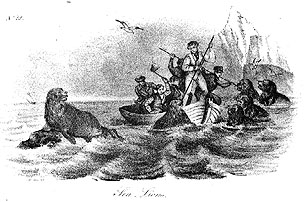
"It is to this new resolution to reassert our indivisibility with life,

to recognize the obligations incumbent upon us as the most powerful and deadly single species ever to exist, and to begin making amends, that my own hopes for a revival and continuance of life on earth now turn. If we persevere in this new way, we may succeed in making man humane ... at last" (Farley Mowat, Sea of Slaughter, pp. 404-405).
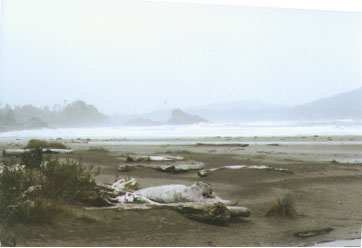
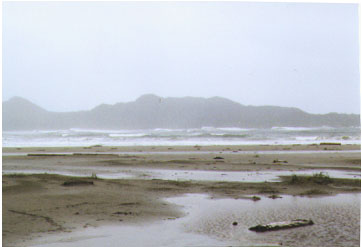
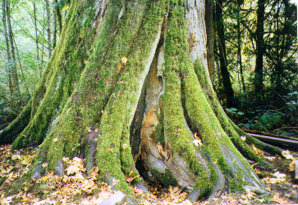
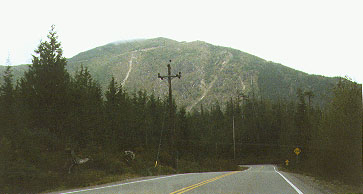
"Acre by acre, the old-growth forests of British Columbia are falling before clear-cutters. Of all the timber harvested in that province since the mid-1800s, more than half has been taken in the past two decades, mostly to meet the new demand from Asia" (The Boston Globe, Friday, November 28, 1997).
Below, left: 19th-century advertising poster and display from the Provincial Museum, Victoria, BC; below right: salmon carved in Washington soapstone by Herb Pelkey, Salish artist from Saanich, Vancouver Island. Native peoples as well as many mammals of the Pacific Northwest relied on the enormous abundance of salmon as a major food source. Today, all species of wild salmon are endangered.
Sooke Salmon Enhancement Society, October 3, 1997. In an attempt to restore the depleted and overfished wild salmon population, volunteers gather to collect sperm and eggs from returning salmon. The hatchlings will be raised in hatcheries until about 4-5 inches long, and then released back into the Sooke River, migrating out to sea, to eventually return inland to spawn. The volunteers report some success with this project, and say that the number of wild salmon has increased since they began their work.
Salmon Returning, Sooke River
It is because they come,
those who can, those who are left,
swimming the upstream and the current,
here, in a dark river bed
swirling with leaves and tannin,
green and rust above pebbles
washed by old seeds
and eons of rising water.
Among Sitka spruce cones
and mossy cedar,
like the forest floor
fulfilled in decay
their lives are hidden,
and it is enough
because they come and I hear
for one hour their silent thrashing.
Salmon returning to spawn, Sooke River, Vancouver Island, October 3, 1997. These are Chinook, the largest species of salmon, about two feet long. They are the long dark shapes in the water.


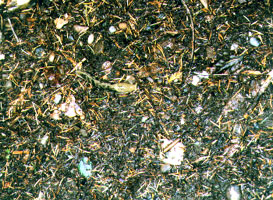

They can build no monuments
They could plant six million trees that had been living there
wherever there are clearcuts and the hills are empty
and let twelve million butterflies rest within them.
They can build no monuments for the Holocaust--nothing fits.
In a hundred years the seedlings will rise, in a thousand
they may stand there still. Let them be green and high and thick.
Let the sea return to them, and the otters,
where no man is.
(©5/31/05 Carol Snyder Halberstadt)
Written after watching a documentary about Germany picking a design for a Holocaust memorial to be built in Berlin ("it must also be 'Art'" said the project director), having seen the clearcut hillsides in British Columbia, and reading The Golden Spruce by John Vaillant.
Who has divided a watercourse for the overflowing of waters, or a way for the lightning of thunder; to cause it to rain on the earth, where no man is; on the wilderness, wherein there is no man; to satisfy the desolate and waste ground; and to cause the bud of the tender herb to spring forth? (--Job 38:2627)
Poems and photographs copyright 1997, 2005,
Carol Snyder Halberstadt.
GO TO MORE VANCOUVER RAINFOREST & SEA MAMMALS, PAGE 4.
Return to Whaling, page 2.
Go to Listening to the Stone pages.
Return to Inuit art page.
Go to Weaving the Light pages.
Go to Storytelling page.
Return to Migrations home page.
